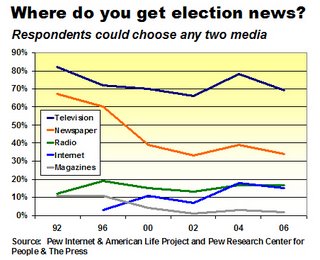Dangerously disconnected
But you can bet your green eyeshade that this would come as stunning news to the platoons of journalists who believe every edition of every newspaper should include a heaping helping of politics.
Eleven years ago, the newspaper people would have been right. But the media marketplace has changed so dramatically in the last decade that there appears to be a dangerous and growing disconnect between the instincts of journalists and the expectations of the people they hope to count as readers.
 Understanding and addressing the profound shift in consumer sentiment is a necessary first step in trying to save our newspapers, because no business can succeed by peddling products that don’t appeal to its intended customer.
Understanding and addressing the profound shift in consumer sentiment is a necessary first step in trying to save our newspapers, because no business can succeed by peddling products that don’t appeal to its intended customer.The abrupt rejection of newspapers as a primary political news vehicle coincides, not surprisingly, with the rapid rise of the Internet as an increasingly popular source of information.
In 1996, 60% of respondents listed newspapers as one of their two primary sources of election news, according to polls from the non-profit Pew research organization. Since 2000, the number of individuals relying on newspapers for political news has declined. Only 34% of respondents last year cited newspapers as a primary news source. You can see how newspapers compare with other media in the chart below.
The Pew poll asks only where people get their election news, but it is fair to hypothesize that print (magazines have taken a tumble, too) is at a hopeless disadvantage to the electronic media when it comes to all manner of breaking and graphic news – from such prosaic matters as stock-market quotes to the chilling video of Saddam Hussein’s hanging.
As market-driven businesses, newspapers urgently must reformulate their products to get in step with their customers. To date, however, the introspection has been shallow and the process has been superficial.
After almost a decade of denial, newspapers finally have begun to recognize that they no longer are going to be the first to deliver the news widely available the previous day on CNN and Google News. But they haven’t developed a compelling alternative to the central mission that once defined them.
Although the Associated Press and many newspapers have learned to top day-old stories with second-day angles, discerning readers won't be satisfied by old news in new ledes. They’re more likely to be insulted.
For newspapers to succeed, they will have to bring fresh and valuable insight to running stories – explaining the background, analyzing the consequences, predicting future developments, profiling key players and so forth. They should do this not only with words, but pictures, charts, maps and graphics.
As a puny but potential replacement for the long-gone, spot-news franchise, the concept of trivialized content got a boost when an experiment found that readers by a margin of 4 to 1 favored a prototype front page plugging Paris Hilton and legalized poker. Paris and poker bested the original paper, which had been led by news of President Bush in Europe and a feature about politicians who blog.
The remix beat the original not because the news was dumbed down, but because the researchers worked harder to present the prototype package than the editors who put out the original. With an equal degree of thought, effort and time, the original stories should have been able to hold their own, if – repeat, if – they were worth doing at all.
Although jumbo graphics have become the latest trend on many front pages (the Newseum gallery brims with good, bad and ugly examples), jazzy packaging won’t fool readers. Among those alarmed by the growing excess for the sake of excess is graphics guru Alan Jacobson, a persuasive advocate for intelligently executed front-page extravaganzas.
“I'm not saying big pictures are killing newspapers, but we should consider what big pictures are crowding out,” he writes. “I'm talking about stories that are relevant to readers, not merely important to editors – relevant stories that drive readership.”
Desperately seeking relevance, papers like the Rocky Mountain News are trying to counter-program the traditional approach to news. To celebrate its new compact format, the Denver tabloid in January kicked off a 33-part series reprising a 1961 tragedy in which 20 children were killed when a train slammed into a school bus.
Launched with, natch, a page-one poster picture, the ambitious undertaking includes a hefty web package of videos, supplementary photos and even original archival material like the school bus sales brochure.
While the Rocky deserves an “A” for effort, you would have to be snowbound for almost five weeks to have sufficient time to plow through each of the thirty-three installments. Are they trying to attract readers or punish them?
To be successful in the future, newspapers have to insinuate themselves into the lives of their readers by consistently delivering must-read, must-see, must-know information that makes them happy, sad, mad – and glad they're spending 20 magical minutes a day with the only thing left in the world that doesn’t require a power supply.
The way to get there is with old-fashioned intellect, shoe leather and gumption. The best newspapers historically have delivered consistent value by providing their readers with exclusive, imaginative, passionate and compassionate stories – and the more local, the better.
Journalists won’t succeed by writing for the Pulitzer board or each other. They need to reconnect with their readers. And they need to do it real soon.



<< Home